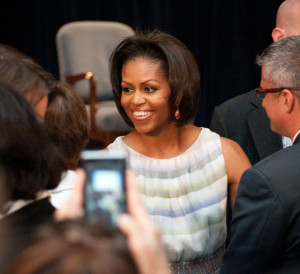By Rain Tiller
In a dark, concealed hall within the mighty Smithsonian Museum is the First Lady exhibit. It’s a long-running D.C. tradition that First Ladies donate a dress to the Smithsonian, some of them their Inaugural gowns. Mary Todd Lincoln, Eleanor Roosevelt, Nancy Reagan, Betty Ford, Hillary Clinton, Michelle Obama, and many other First Ladies are represented in collection. Dimly lit with shafts of light emanating over the gowns, the dresses appear to have a phantasmal glow. Walking through the small exhibit, I could feel the First Ladies take up space around me. I could tell how all Michelle Obama is, or how short Mary Todd Lincoln was. Surrounded by all these historic women, I began to feel the immediacy of their authority and elegance. Their spirits were commanding respect.
The Smithsonian exhibit reminds me that the First Lady is an underestimated position of power. From Dolly Madison, who saved historical artifacts from the burning White House, to Eleanor Roosevelt who wielded her power and intellect to better the lives of women. From Nancy Reagan, who started the famous “Just Say No” anti-drug campaign, to Jackie Kennedy, who restored the White House and influenced fashion for decades. The marital seat beside the President has been an important position for women in politics, whether through symbolic acts or real-deal policy.
Today, there are a lot of First Ladies being considered in American politics. A former First Lady, Hillary Clinton. The current first Lady, Michelle Obama. And a potential First Lady, Melania Trump.
At the DNC, Hillary Clinton made history by becoming the official Democratic nominee for President. The night before the nomination was announced, current First Lady Michelle Obama took the stage to deliver a speech that titillated the DNC and lit the internet aflame. Before the night’s end, news articles, blogs, and tweets were shooting off into the world with one resounding message:
People wanted Michelle Obama to be the President of the United States.
That night, Michelle Obama voiced to the world her support of Hillary Clinton. But that speech was about so much more. She talked about fighting against hate, rising above it. She related to the nation as a caring parent, a loving mother. She spoke about the importance of positive leadership for people of color, poor people, immigrants, and their children. Strength and perseverance. And she appealed to the history of our nation: its growth from slavery and segregation; its values of equality and togetherness. And to the future of our nation: devotion, opportunity, and hope.
Eight years of being the “FLOTUS with the mostess” and a moving convention speech wins Michelle Obama the electoral heart of the public. With Hillary Clinton now the Democrats’ hope for the White House, it’s time to ask an important question: How does one get from FLOTUS to POTUS?
Hillary Clinton is writing the book on that it seems. It’s been fifteen years since she served as First Lady. Outside of being one of the most engaged First Ladies, Clinton was also a powerful attorney and Senator. Michelle Obama too has spent the last eight years as a well-liked and active member of the White House. Like Clinton, before Barack Obama was elected in 2008, she was a powerhouse lawyer and the University of Chicago Hospitals’ Vice President of Community and External Affairs. Hillary Clinton and Michelle Obama are also two of the three First Ladies to ever have postgraduate degrees, Laura Bush being the third.
A pattern is forming. First Ladies are becoming more and more visible and impactful. Even Laura Bush, whose husband was deeply conservative, had an active role in the United States’ intake of refugees. Specifically in North Carolina, she helped increase the influx of Burmese and Karen refugees in the Chapel Hill and Carrboro community.
As the election continues and Michelle Obama’s First Ladyship comes to an end, it’s time to start thinking about the role of FLOTUS in a new light. Is this the way we get more women in the Oval Office? Has the position of First Lady become a mechanism by which women can gain the political capital needed to run for President? Is the move into the Presidency a lateral one? George W. Bush became President just two terms after his father left office. If a First Son can become Commander-in-Chief, who’s to say that the First Lady can’t as well?
For the next First Lady, whether she come into the White House next year or eight years from now, this pattern of growth changes what her role can mean. Not all First Ladies will make the leap to the Presidency– and not all female Presidents will have been First Ladies. But the new political weight of the First Ladyship has shown us that the office of the First Lady is a powerful one. Her role should be active. She should be a participating policy maker. Her biggest impact is no longer redecorating the White House or selecting the china for the next banquet. Her place is on the campaign trail and in the capitol. And for some of them, her place is also in the Oval Office.
FLOTUS to POTUS might just be the most important landmark for women in politics yet.


There are no comments
Add yours